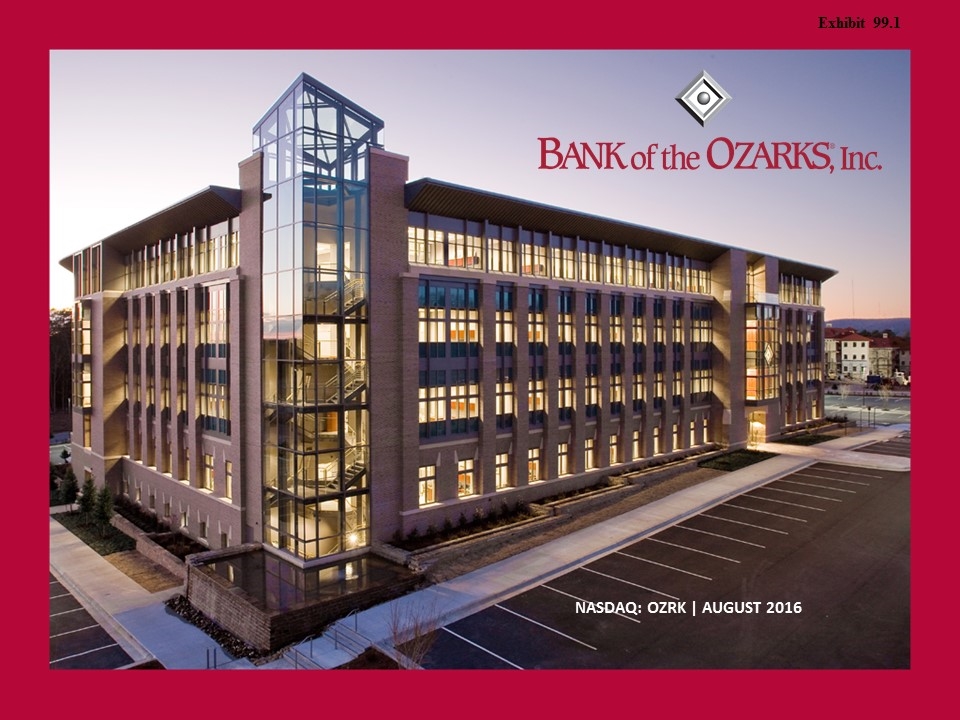
Nasdaq: OZRK | August 2016 0 Exhibit 99.1
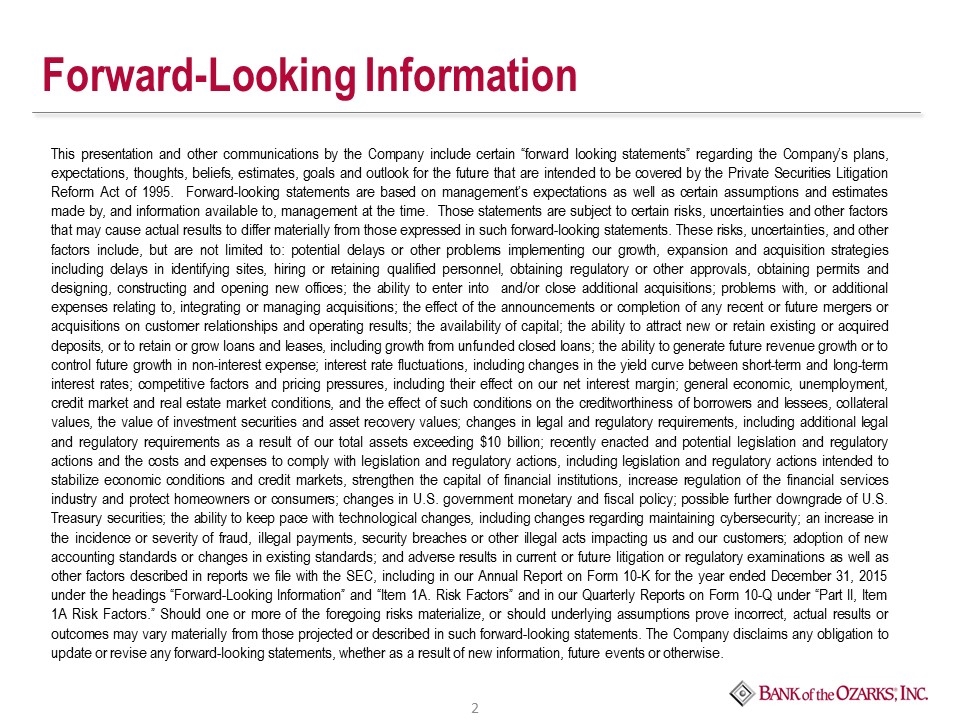
This presentation and other communications by the Company include certain “forward looking statements” regarding the Company’s plans, expectations, thoughts, beliefs, estimates, goals and outlook for the future that are intended to be covered by the Private Securities Litigation Reform Act of 1995. Forward-looking statements are based on management’s expectations as well as certain assumptions and estimates made by, and information available to, management at the time. Those statements are subject to certain risks, uncertainties and other factors that may cause actual results to differ materially from those expressed in such forward-looking statements. These risks, uncertainties, and other factors include, but are not limited to: potential delays or other problems implementing our growth, expansion and acquisition strategies including delays in identifying sites, hiring or retaining qualified personnel, obtaining regulatory or other approvals, obtaining permits and designing, constructing and opening new offices; the ability to enter into and/or close additional acquisitions; problems with, or additional expenses relating to, integrating or managing acquisitions; the effect of the announcements or completion of any recent or future mergers or acquisitions on customer relationships and operating results; the availability of capital; the ability to attract new or retain existing or acquired deposits, or to retain or grow loans and leases, including growth from unfunded closed loans; the ability to generate future revenue growth or to control future growth in non-interest expense; interest rate fluctuations, including changes in the yield curve between short-term and long-term interest rates; competitive factors and pricing pressures, including their effect on our net interest margin; general economic, unemployment, credit market and real estate market conditions, and the effect of such conditions on the creditworthiness of borrowers and lessees, collateral values, the value of investment securities and asset recovery values; changes in legal and regulatory requirements, including additional legal and regulatory requirements as a result of our total assets exceeding $10 billion; recently enacted and potential legislation and regulatory actions and the costs and expenses to comply with legislation and regulatory actions, including legislation and regulatory actions intended to stabilize economic conditions and credit markets, strengthen the capital of financial institutions, increase regulation of the financial services industry and protect homeowners or consumers; changes in U.S. government monetary and fiscal policy; possible further downgrade of U.S. Treasury securities; the ability to keep pace with technological changes, including changes regarding maintaining cybersecurity; an increase in the incidence or severity of fraud, illegal payments, security breaches or other illegal acts impacting us and our customers; adoption of new accounting standards or changes in existing standards; and adverse results in current or future litigation or regulatory examinations as well as other factors described in reports we file with the SEC, including in our Annual Report on Form 10-K for the year ended December 31, 2015 under the headings “Forward-Looking Information” and “Item 1A. Risk Factors” and in our Quarterly Reports on Form 10-Q under “Part II, Item 1A Risk Factors.” Should one or more of the foregoing risks materialize, or should underlying assumptions prove incorrect, actual results or outcomes may vary materially from those projected or described in such forward-looking statements. The Company disclaims any obligation to update or revise any forward-looking statements, whether as a result of new information, future events or otherwise. Forward-Looking Information
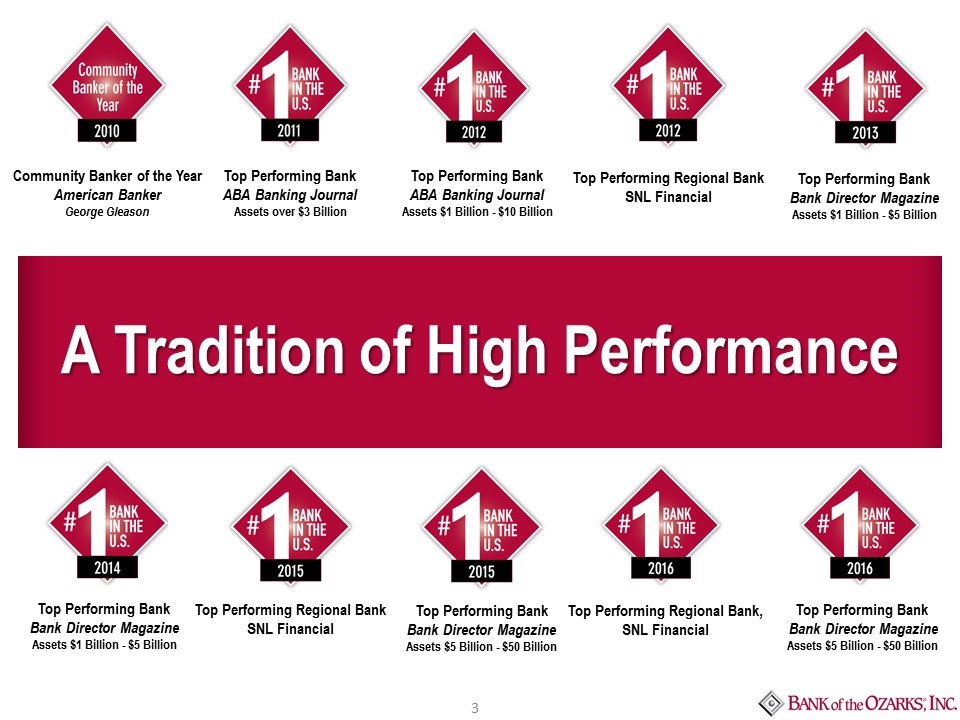
A Tradition of High Performance Top Performing Bank ABA Banking Journal Assets over $3 Billion Top Performing Bank ABA Banking Journal Assets $1 Billion - $10 Billion Top Performing Regional Bank SNL Financial Top Performing Bank Bank Director Magazine Assets $1 Billion - $5 Billion Community Banker of the Year American Banker George Gleason Top Performing Bank Bank Director Magazine Assets $1 Billion - $5 Billion Top Performing Regional Bank SNL Financial Top Performing Bank Bank Director Magazine Assets $5 Billion - $50 Billion Top Performing Regional Bank, SNL Financial Top Performing Bank Bank Director Magazine Assets $5 Billion - $50 Billion
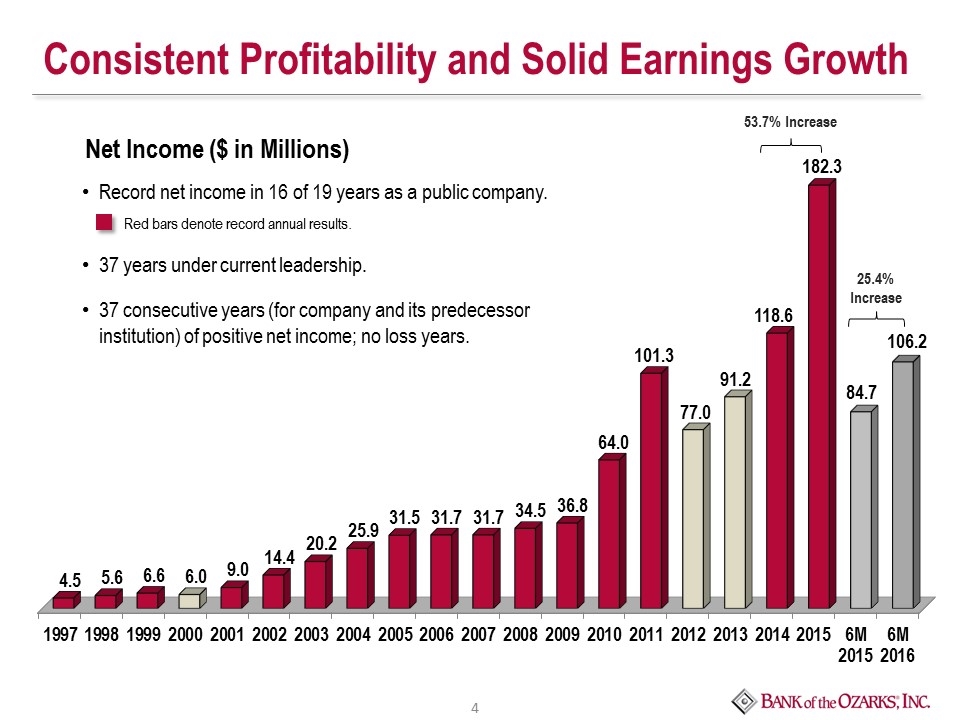
Consistent Profitability and Solid Earnings Growth Record net income in 16 of 19 years as a public company. 37 years under current leadership. 37 consecutive years (for company and its predecessor institution) of positive net income; no loss years. Net Income ($ in Millions) Red bars denote record annual results.
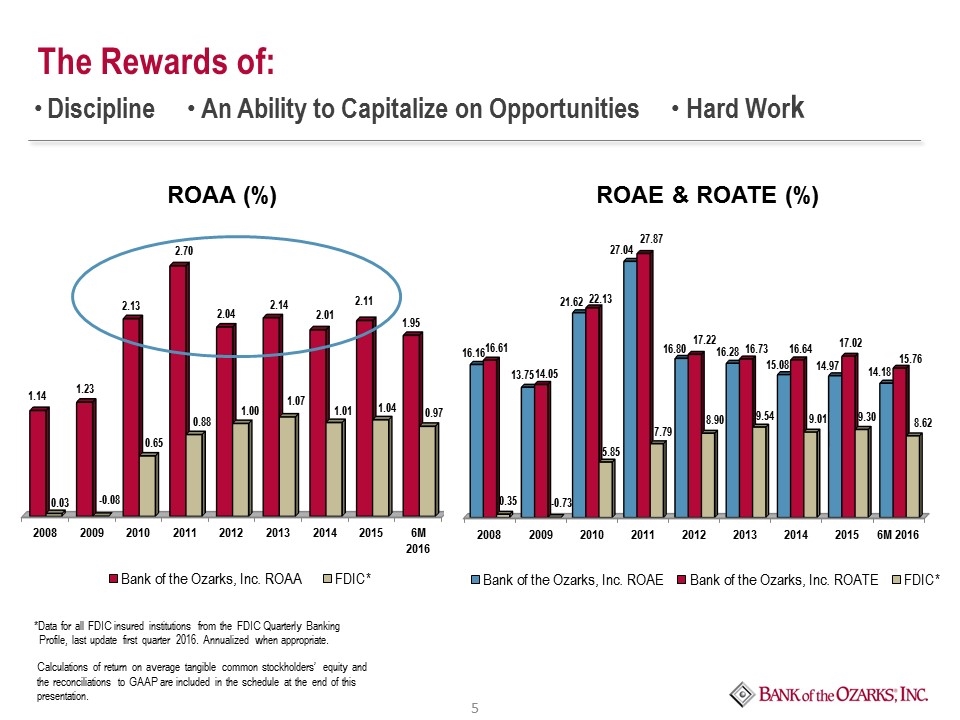
ROAE & ROATE (%) *Data for all FDIC insured institutions from the FDIC Quarterly Banking Profile, last update first quarter 2016. Annualized when appropriate. Calculations of return on average tangible common stockholders’ equity and the reconciliations to GAAP are included in the schedule at the end of this presentation. The Rewards of: ROAA (%) ● Discipline ● An Ability to Capitalize on Opportunities ● Hard Work
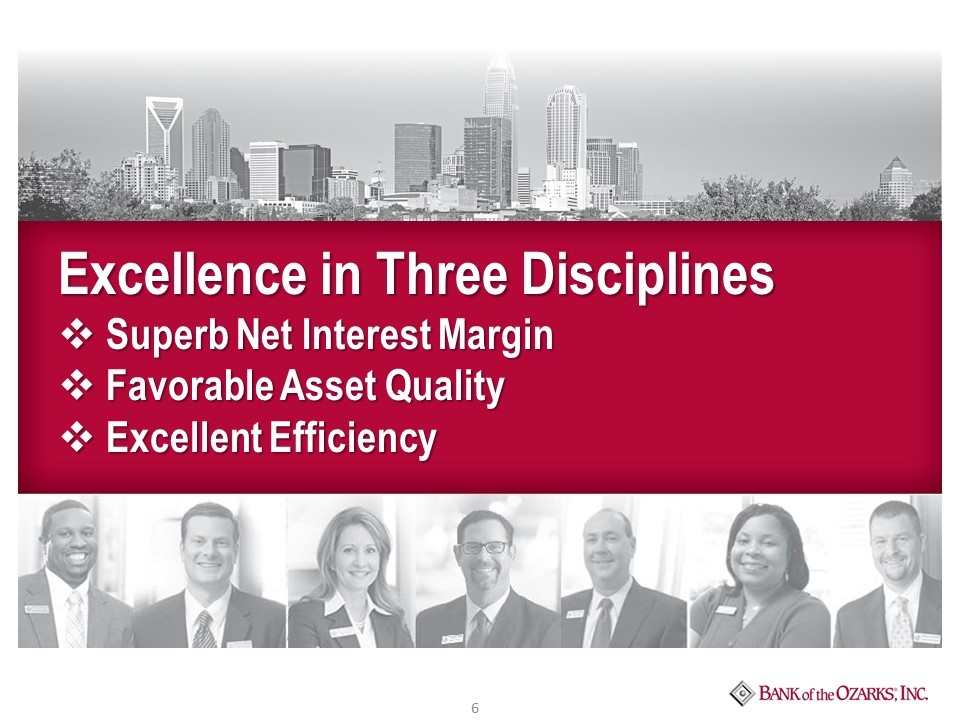
Excellence in Three Disciplines Superb Net Interest Margin Favorable Asset Quality Excellent Efficiency
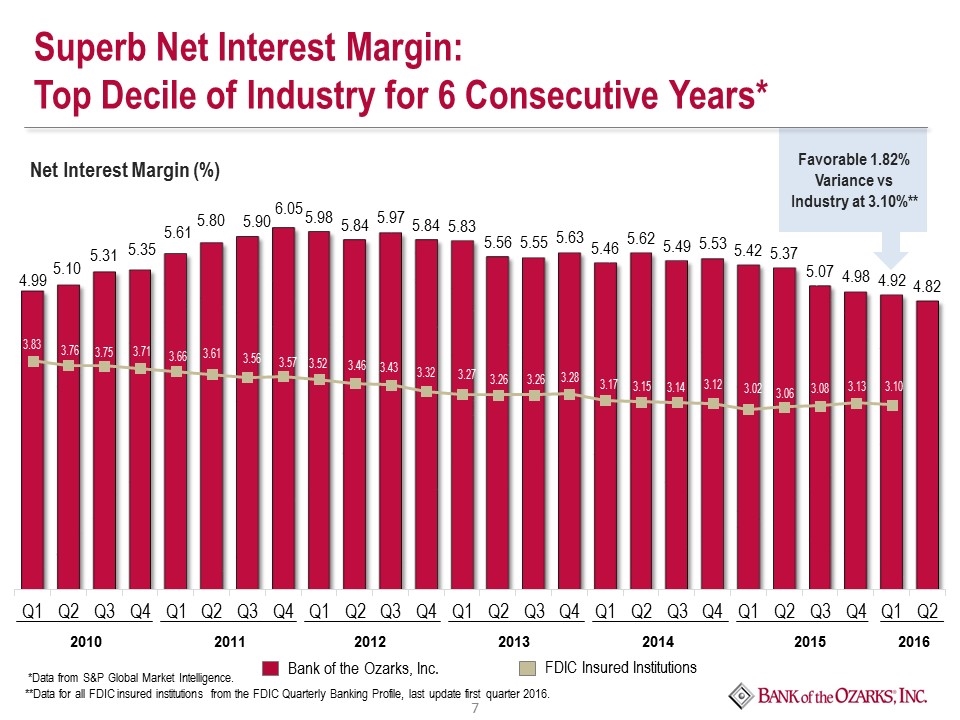
*Data from S&P Global Market Intelligence. **Data for all FDIC insured institutions from the FDIC Quarterly Banking Profile, last update first quarter 2016. Favorable 1.82% Variance vs Industry at 3.10%** Superb Net Interest Margin: Top Decile of Industry for 6 Consecutive Years* Bank of the Ozarks, Inc. FDIC Insured Institutions 2010 2011 2012 2013 2014 2015 2016 Net Interest Margin (%)
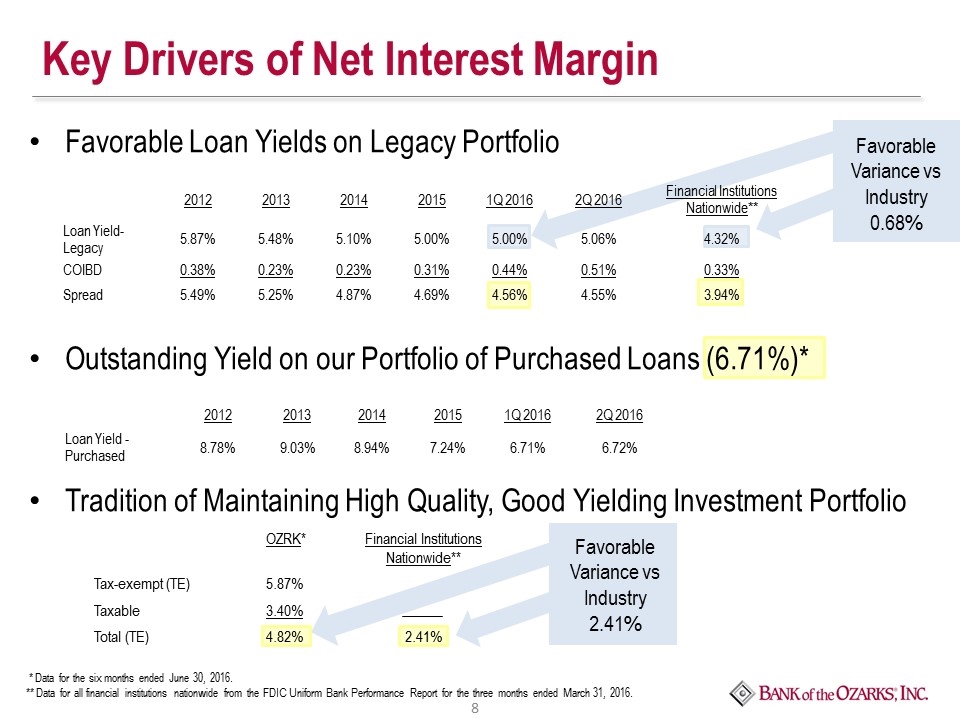
Favorable Loan Yields on Legacy Portfolio Outstanding Yield on our Portfolio of Purchased Loans (6.71%)* Tradition of Maintaining High Quality, Good Yielding Investment Portfolio OZRK* Financial Institutions Nationwide** Tax-exempt (TE) 5.87% Taxable 3.40% Total (TE) 4.82% 2.41% 2012 2013 2014 2015 1Q 2016 2Q 2016 Financial Institutions Nationwide** Loan Yield-Legacy 5.87% 5.48% 5.10% 5.00% 5.00% 5.06% 4.32% COIBD 0.38% 0.23% 0.23% 0.31% 0.44% 0.51% 0.33% Spread 5.49% 5.25% 4.87% 4.69% 4.56% 4.55% 3.94% * Data for the six months ended June 30, 2016. ** Data for all financial institutions nationwide from the FDIC Uniform Bank Performance Report for the three months ended March 31, 2016. Favorable Variance vs Industry 0.68% Key Drivers of Net Interest Margin 2012 2013 2014 2015 1Q 2016 2Q 2016 Loan Yield - Purchased 8.78% 9.03% 8.94% 7.24% 6.71% 6.72% Favorable Variance vs Industry 2.41%
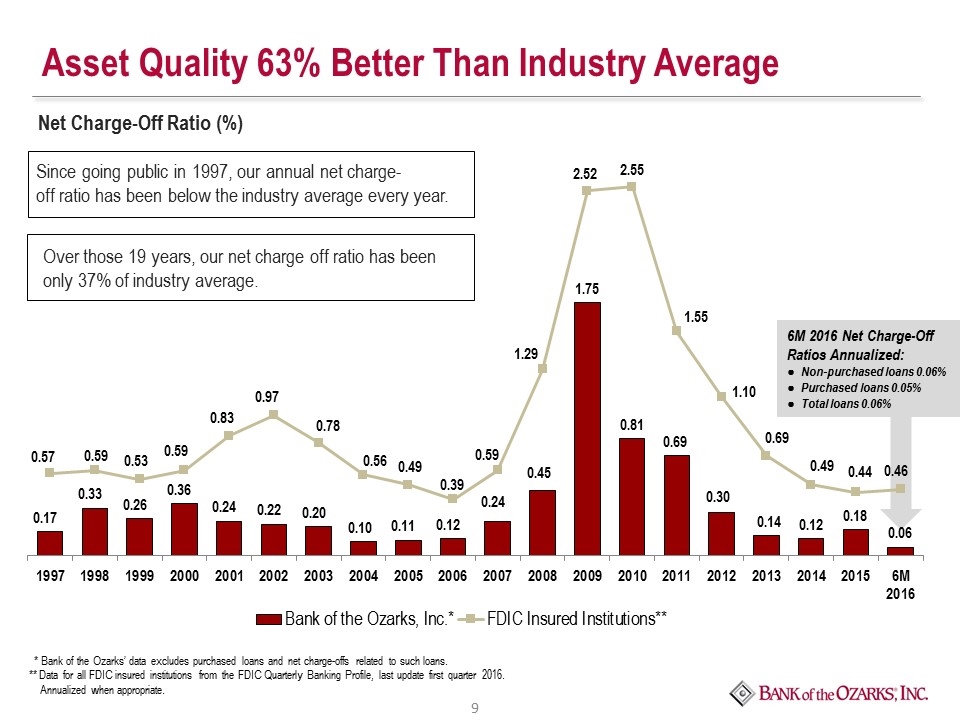
* Bank of the Ozarks’ data excludes purchased loans and net charge-offs related to such loans. ** Data for all FDIC insured institutions from the FDIC Quarterly Banking Profile, last update first quarter 2016. Annualized when appropriate. Asset Quality 63% Better Than Industry Average Since going public in 1997, our annual net charge- off ratio has been below the industry average every year. 6M 2016 Net Charge-Off Ratios Annualized: ● Non-purchased loans 0.06% ● Purchased loans 0.05% ● Total loans 0.06% Net Charge-Off Ratio (%) Over those 19 years, our net charge off ratio has been only 37% of industry average.
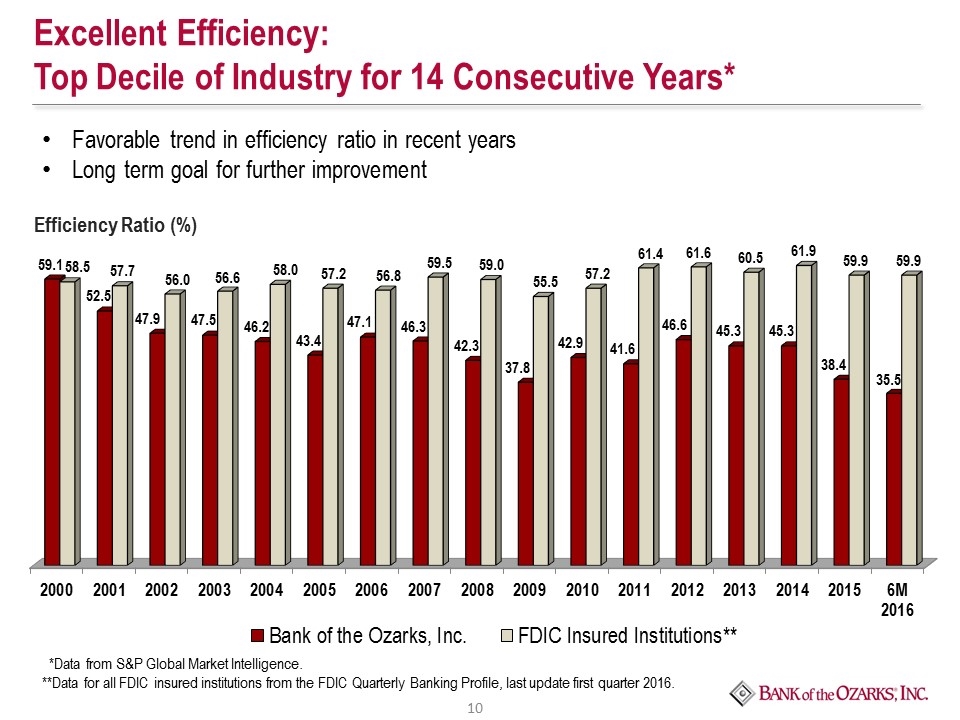
*Data from S&P Global Market Intelligence. **Data for all FDIC insured institutions from the FDIC Quarterly Banking Profile, last update first quarter 2016. Excellent Efficiency: Top Decile of Industry for 14 Consecutive Years* Efficiency Ratio (%) Favorable trend in efficiency ratio in recent years Long term goal for further improvement
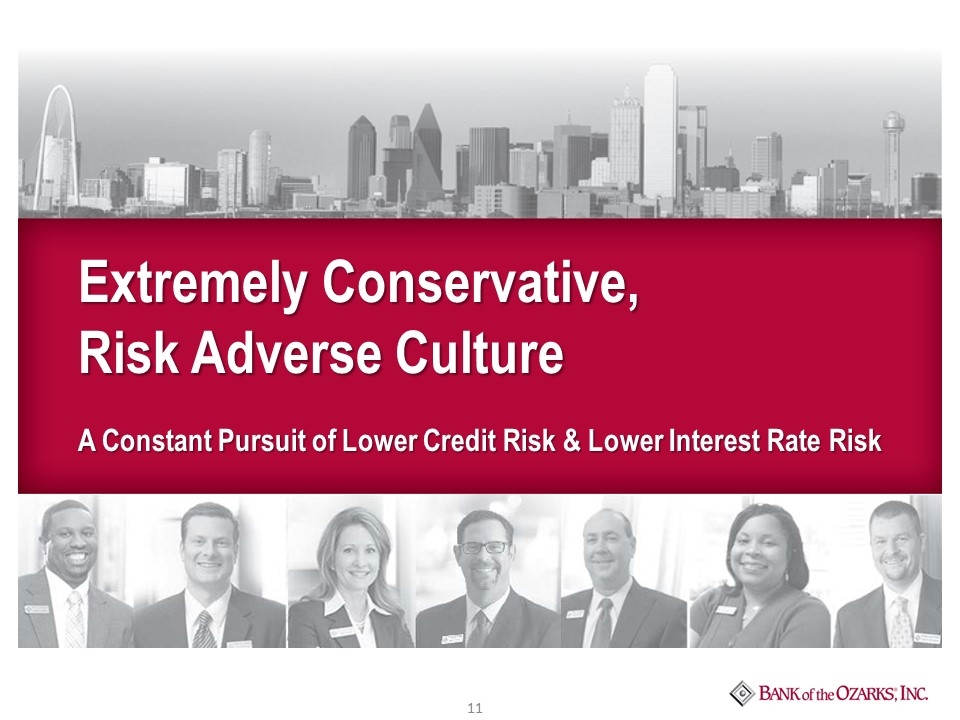
Extremely Conservative, Risk Adverse Culture A Constant Pursuit of Lower Credit Risk & Lower Interest Rate Risk
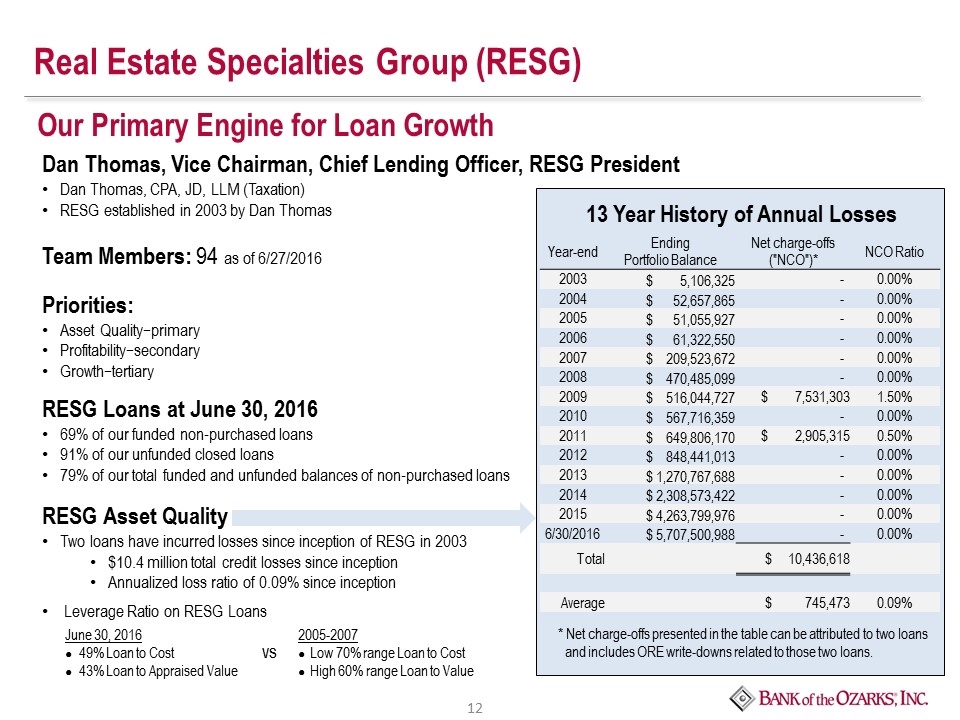
Dan Thomas, Vice Chairman, Chief Lending Officer, RESG President Dan Thomas, CPA, JD, LLM (Taxation) RESG established in 2003 by Dan Thomas Team Members: 94 as of 6/27/2016 Priorities: Asset Quality−primary Profitability−secondary Growth−tertiary RESG Loans at June 30, 2016 69% of our funded non-purchased loans 91% of our unfunded closed loans 79% of our total funded and unfunded balances of non-purchased loans RESG Asset Quality Two loans have incurred losses since inception of RESG in 2003 $10.4 million total credit losses since inception Annualized loss ratio of 0.09% since inception Leverage Ratio on RESG Loans Real Estate Specialties Group (RESG) 13 Year History of Annual Losses Year-end Ending Portfolio Balance Net charge-offs ("NCO")* NCO Ratio 2003 $ 5,106,325 - 0.00% 2004 $ 52,657,865 - 0.00% 2005 $ 51,055,927 - 0.00% 2006 $ 61,322,550 - 0.00% 2007 $ 209,523,672 - 0.00% 2008 $ 470,485,099 - 0.00% 2009 $ 516,044,727 $ 7,531,303 1.50% 2010 $ 567,716,359 - 0.00% 2011 $ 649,806,170 $ 2,905,315 0.50% 2012 $ 848,441,013 - 0.00% 2013 $ 1,270,767,688 - 0.00% 2014 $ 2,308,573,422 - 0.00% 2015 $ 4,263,799,976 - 0.00% 6/30/2016 $ 5,707,500,988 - 0.00% Total $ 10,436,618 Average $ 745,473 0.09% 2005-2007 ● Low 70% range Loan to Cost ● High 60% range Loan to Value June 30, 2016 ● 49% Loan to Cost ● 43% Loan to Appraised Value vs * Net charge-offs presented in the table can be attributed to two loans and includes ORE write-downs related to those two loans. Our Primary Engine for Loan Growth
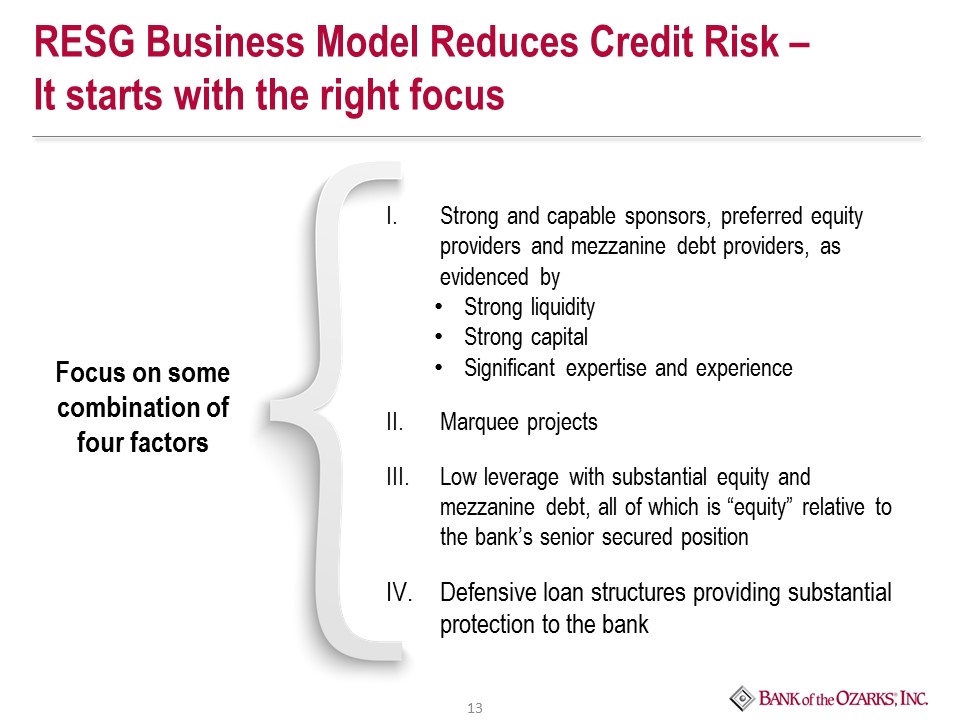
RESG Business Model Reduces Credit Risk – It starts with the right focus Strong and capable sponsors, preferred equity providers and mezzanine debt providers, as evidenced by Strong liquidity Strong capital Significant expertise and experience Marquee projects Low leverage with substantial equity and mezzanine debt, all of which is “equity” relative to the bank’s senior secured position Defensive loan structures providing substantial protection to the bank Focus on some combination of four factors
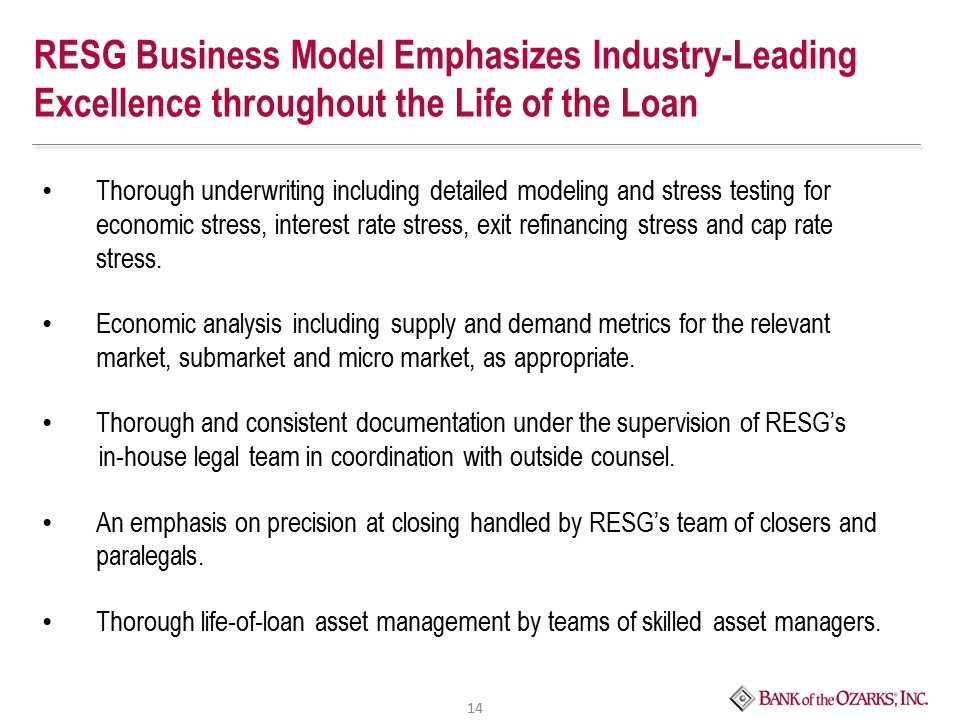
RESG Business Model Emphasizes Industry-Leading Excellence throughout the Life of the Loan Thorough underwriting including detailed modeling and stress testing for economic stress, interest rate stress, exit refinancing stress and cap rate stress. Economic analysis including supply and demand metrics for the relevant market, submarket and micro market, as appropriate. Thorough and consistent documentation under the supervision of RESG’s in-house legal team in coordination with outside counsel. An emphasis on precision at closing handled by RESG’s team of closers and paralegals. Thorough life-of-loan asset management by teams of skilled asset managers.
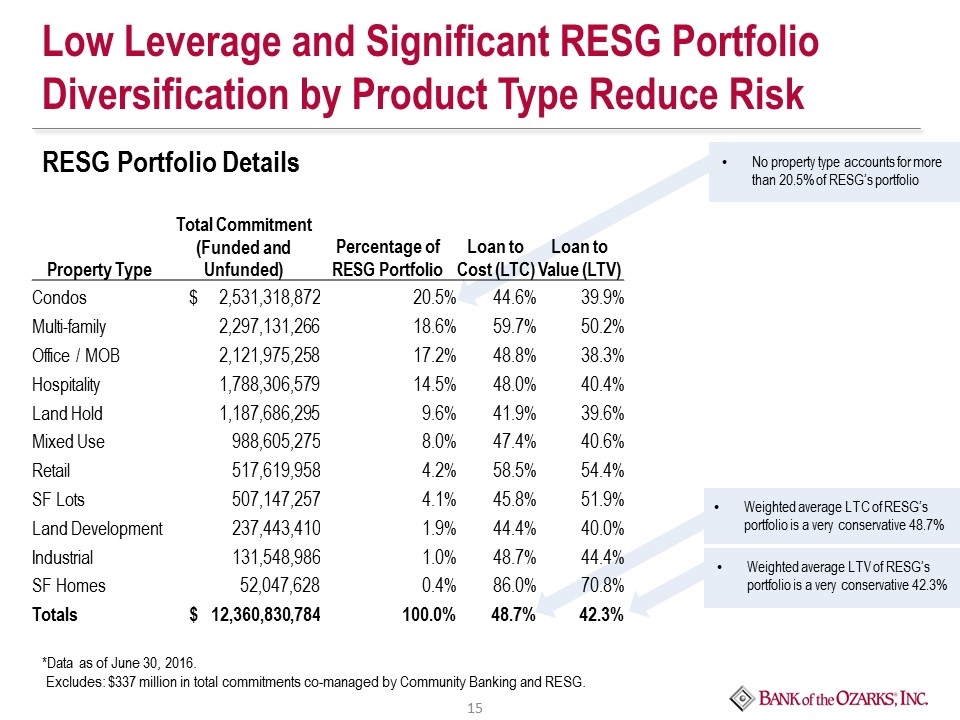
Weighted average LTV of RESG’s portfolio is a very conservative 42.3% Property Type Total Commitment (Funded and Unfunded) Percentage of RESG Portfolio Loan to Cost (LTC) Loan to Value (LTV) Condos $ 2,531,318,872 20.5% 44.6% 39.9% Multi-family 2,297,131,266 18.6% 59.7% 50.2% Office / MOB 2,121,975,258 17.2% 48.8% 38.3% Hospitality 1,788,306,579 14.5% 48.0% 40.4% Land Hold 1,187,686,295 9.6% 41.9% 39.6% Mixed Use 988,605,275 8.0% 47.4% 40.6% Retail 517,619,958 4.2% 58.5% 54.4% SF Lots 507,147,257 4.1% 45.8% 51.9% Land Development 237,443,410 1.9% 44.4% 40.0% Industrial 131,548,986 1.0% 48.7% 44.4% SF Homes 52,047,628 0.4% 86.0% 70.8% Totals $ 12,360,830,784 100.0% 48.7% 42.3% Low Leverage and Significant RESG Portfolio Diversification by Product Type Reduce Risk RESG Portfolio Details *Data as of June 30, 2016. Excludes: $337 million in total commitments co-managed by Community Banking and RESG. No property type accounts for more than 20.5% of RESG’s portfolio Weighted average LTC of RESG’s portfolio is a very conservative 48.7%
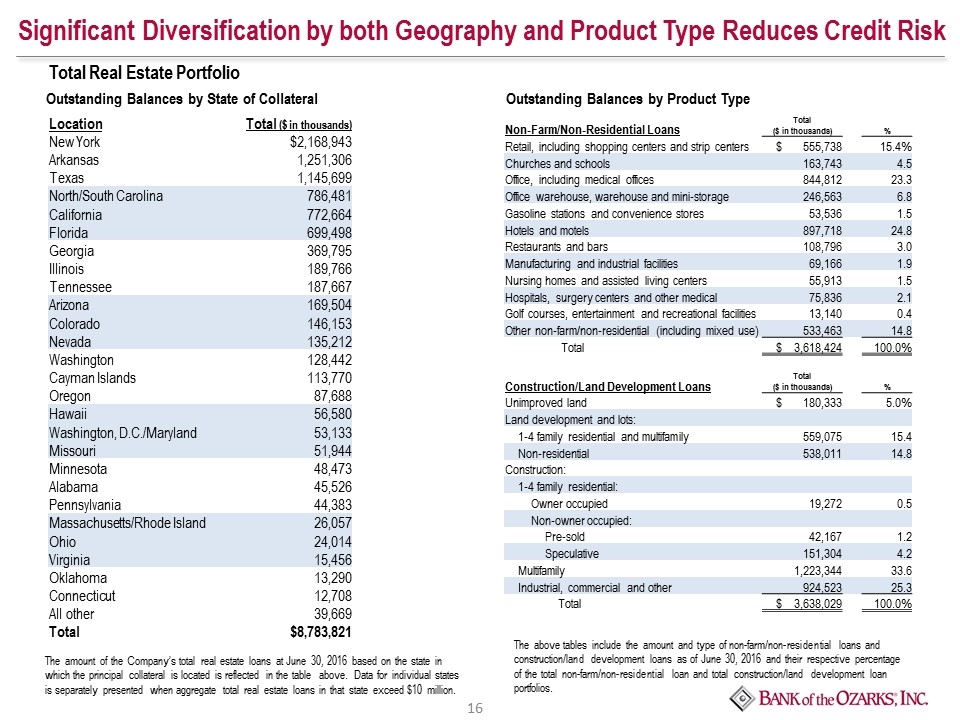
The amount of the Company’s total real estate loans at June 30, 2016 based on the state in which the principal collateral is located is reflected in the table above. Data for individual states is separately presented when aggregate total real estate loans in that state exceed $10 million. Significant Diversification by both Geography and Product Type Reduces Credit Risk Total Real Estate Portfolio The above tables include the amount and type of non-farm/non-residential loans and construction/land development loans as of June 30, 2016 and their respective percentage of the total non-farm/non-residential loan and total construction/land development loan portfolios. Outstanding Balances by Product Type Outstanding Balances by State of Collateral Non-Farm/Non-Residential Loans Total ($ in thousands) % Retail, including shopping centers and strip centers $ 555,738 15.4% Churches and schools 163,743 4.5 Office, including medical offices 844,812 23.3 Office warehouse, warehouse and mini-storage 246,563 6.8 Gasoline stations and convenience stores 53,536 1.5 Hotels and motels 897,718 24.8 Restaurants and bars 108,796 3.0 Manufacturing and industrial facilities 69,166 1.9 Nursing homes and assisted living centers 55,913 1.5 Hospitals, surgery centers and other medical 75,836 2.1 Golf courses, entertainment and recreational facilities 13,140 0.4 Other non-farm/non-residential (including mixed use) 533,463 14.8 Total $ 3,618,424 100.0% Construction/Land Development Loans Total ($ in thousands) % Unimproved land $ 180,333 5.0% Land development and lots: 1-4 family residential and multifamily 559,075 15.4 Non-residential 538,011 14.8 Construction: 1-4 family residential: Owner occupied 19,272 0.5 Non-owner occupied: Pre-sold 42,167 1.2 Speculative 151,304 4.2 Multifamily 1,223,344 33.6 Industrial, commercial and other 924,523 25.3 Total $ 3,638,029 100.0% Location Total ($ in thousands) New York $2,168,943 Arkansas 1,251,306 Texas 1,145,699 North/South Carolina 786,481 California 772,664 Florida 699,498 Georgia 369,795 Illinois 189,766 Tennessee 187,667 Arizona 169,504 Colorado 146,153 Nevada 135,212 Washington 128,442 Cayman Islands 113,770 Oregon 87,688 Hawaii 56,580 Washington, D.C./Maryland 53,133 Missouri 51,944 Minnesota 48,473 Alabama 45,526 Pennsylvania 44,383 Massachusetts/Rhode Island 26,057 Ohio 24,014 Virginia 15,456 Oklahoma 13,290 Connecticut 12,708 All other 39,669 Total $8,783,821
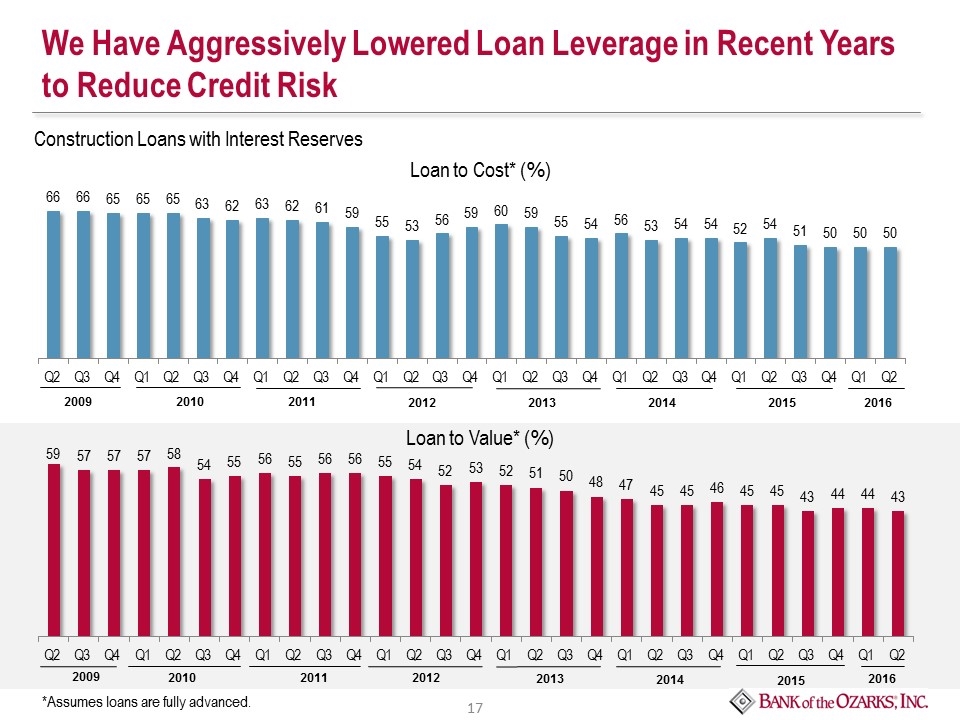
Construction Loans with Interest Reserves We Have Aggressively Lowered Loan Leverage in Recent Years to Reduce Credit Risk *Assumes loans are fully advanced. 2010 2009 Loan to Value* (%) Loan to Cost* (%) 2010 2011 2012 2013 2014 2009 2011 2012 2013 2014 2015 2015 2014 2016 2016
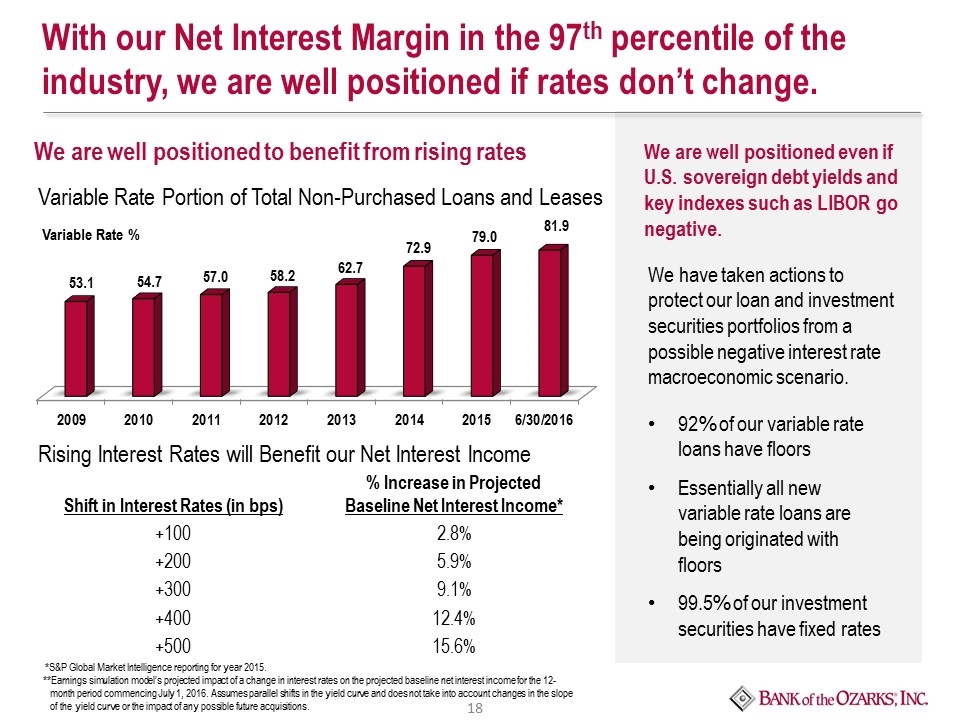
Shift in Interest Rates (in bps) % Increase in Projected Baseline Net Interest Income* +100 2.8% +200 5.9% +300 9.1% +400 12.4% +500 15.6% *S&P Global Market Intelligence reporting for year 2015. **Earnings simulation model’s projected impact of a change in interest rates on the projected baseline net interest income for the 12- month period commencing July 1, 2016. Assumes parallel shifts in the yield curve and does not take into account changes in the slope of the yield curve or the impact of any possible future acquisitions. With our Net Interest Margin in the 97th percentile of the industry, we are well positioned if rates don’t change. Rising Interest Rates will Benefit our Net Interest Income We have taken actions to protect our loan and investment securities portfolios from a possible negative interest rate macroeconomic scenario. 92% of our variable rate loans have floors Essentially all new variable rate loans are being originated with floors 99.5% of our investment securities have fixed rates Variable Rate Portion of Total Non-Purchased Loans and Leases Variable Rate % We are well positioned to benefit from rising rates We are well positioned even if U.S. sovereign debt yields and key indexes such as LIBOR go negative.
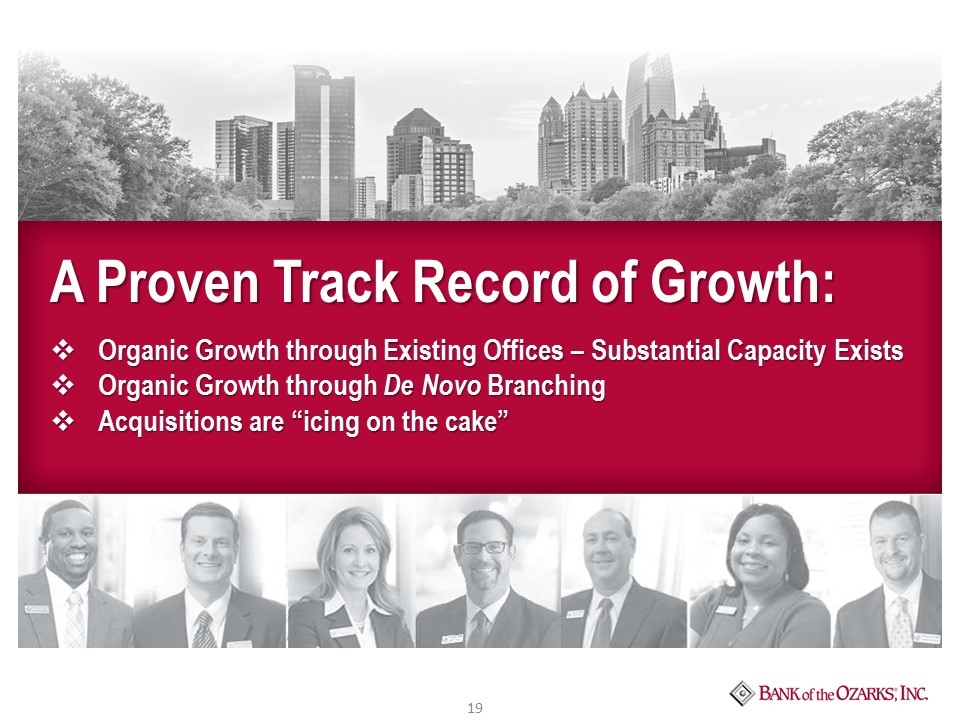
A Proven Track Record of Growth: Organic Growth through Existing Offices – Substantial Capacity Exists Organic Growth through De Novo Branching Acquisitions are “icing on the cake”
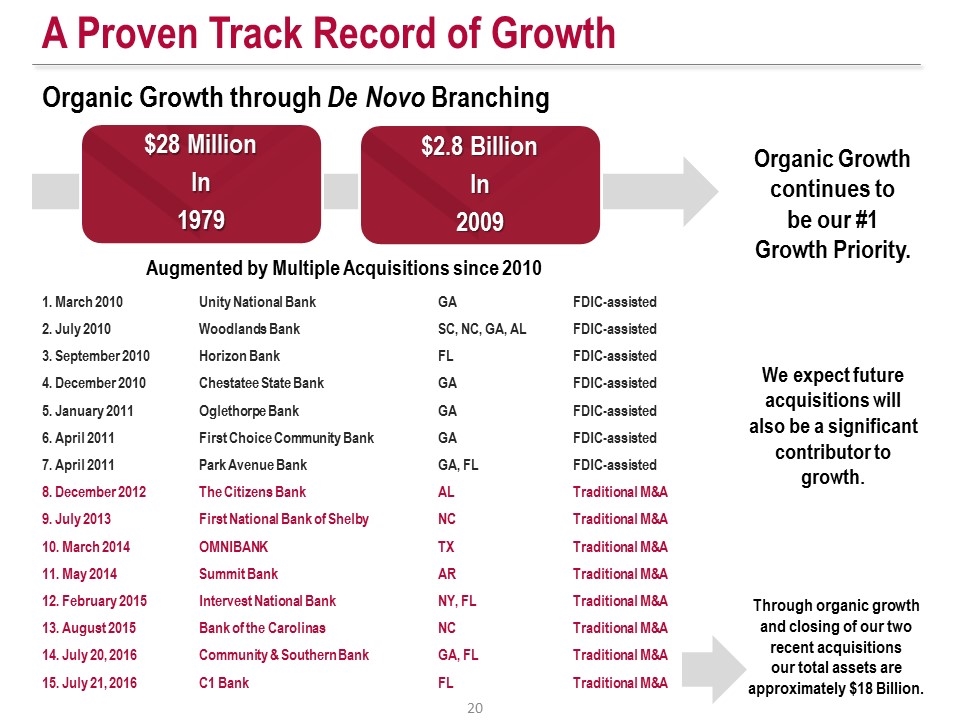
1. March 2010 Unity National Bank GA FDIC-assisted 2. July 2010 Woodlands Bank SC, NC, GA, AL FDIC-assisted 3. September 2010 Horizon Bank FL FDIC-assisted 4. December 2010 Chestatee State Bank GA FDIC-assisted 5. January 2011 Oglethorpe Bank GA FDIC-assisted 6. April 2011 First Choice Community Bank GA FDIC-assisted 7. April 2011 Park Avenue Bank GA, FL FDIC-assisted 8. December 2012 The Citizens Bank AL Traditional M&A 9. July 2013 First National Bank of Shelby NC Traditional M&A 10. March 2014 OMNIBANK TX Traditional M&A 11. May 2014 Summit Bank AR Traditional M&A 12. February 2015 Intervest National Bank NY, FL Traditional M&A 13. August 2015 Bank of the Carolinas NC Traditional M&A 14. July 20, 2016 Community & Southern Bank GA, FL Traditional M&A 15. July 21, 2016 C1 Bank FL Traditional M&A Organic Growth through De Novo Branching A Proven Track Record of Growth Organic Growth continues to be our #1 Growth Priority. We expect future acquisitions will also be a significant contributor to growth. Through organic growth and closing of our two recent acquisitions our total assets are approximately $18 Billion. Augmented by Multiple Acquisitions since 2010 $28 Million In 1979 $2.8 Billion In 2009
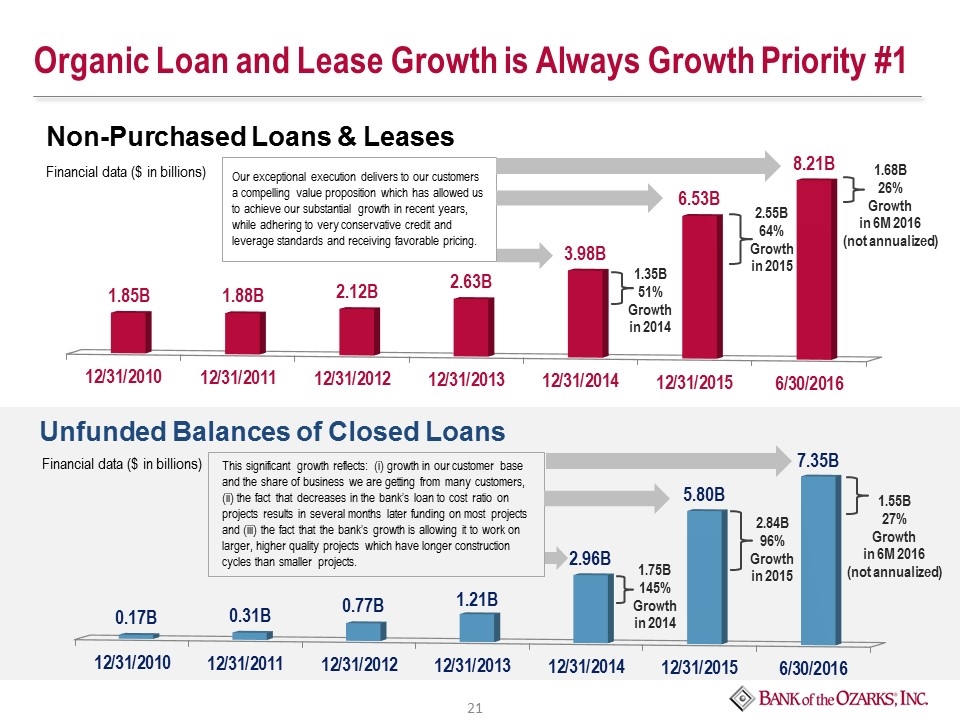
1.75B 145% Growth in 2014 1.35B 51% Growth in 2014 2.55B 64% Growth in 2015 Unfunded Balances of Closed Loans Financial data ($ in billions) Non-Purchased Loans & Leases Organic Loan and Lease Growth is Always Growth Priority #1 Financial data ($ in billions) 2.84B 96% Growth in 2015 1.68B 26% Growth in 6M 2016 (not annualized) 1.55B 27% Growth in 6M 2016 (not annualized) Our exceptional execution delivers to our customers a compelling value proposition which has allowed us to achieve our substantial growth in recent years, while adhering to very conservative credit and leverage standards and receiving favorable pricing. This significant growth reflects: (i) growth in our customer base and the share of business we are getting from many customers, (ii) the fact that decreases in the bank’s loan to cost ratio on projects results in several months later funding on most projects and (iii) the fact that the bank’s growth is allowing it to work on larger, higher quality projects which have longer construction cycles than smaller projects.
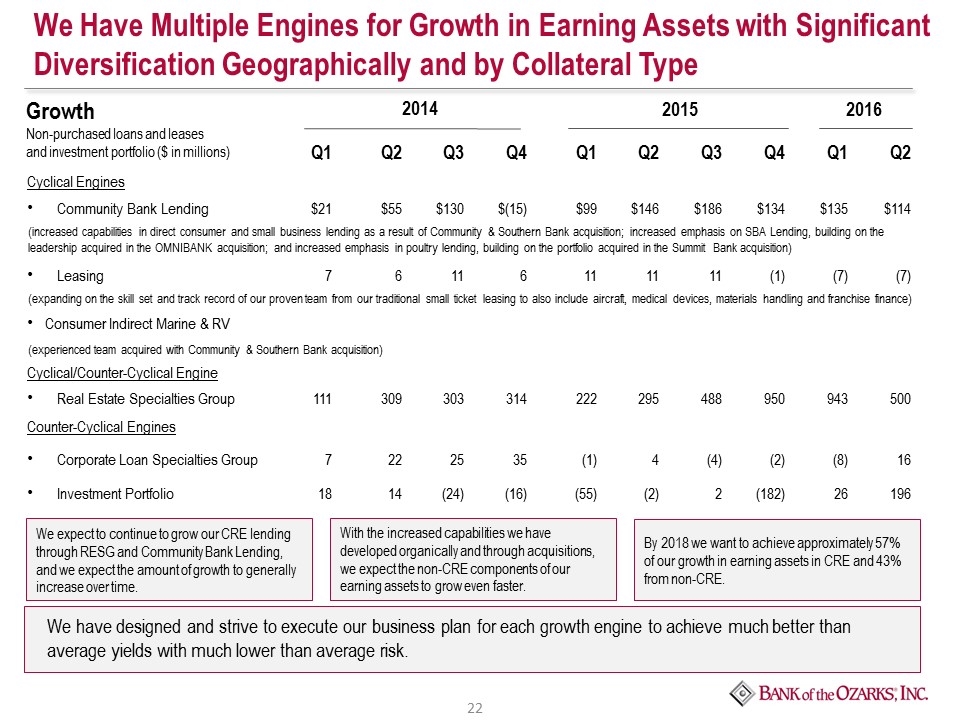
By 2018 we want to achieve approximately 57% of our growth in earning assets in CRE and 43% from non-CRE. With the increased capabilities we have developed organically and through acquisitions, we expect the non-CRE components of our earning assets to grow even faster. We expect to continue to grow our CRE lending through RESG and Community Bank Lending, and we expect the amount of growth to generally increase over time. Q1 Q2 Q3 Q4 Q1 Q2 Q3 Q4 Q1 Q2 Cyclical Engines Community Bank Lending $21 $55 $130 $(15) $99 $146 $186 $134 $135 $114 Leasing 7 6 11 6 11 11 11 (1) (7) (7) Consumer Indirect Marine & RV Cyclical/Counter-Cyclical Engine Real Estate Specialties Group 111 309 303 314 222 295 488 950 943 500 Counter-Cyclical Engines Corporate Loan Specialties Group 7 22 25 35 (1) 4 (4) (2) (8) 16 Investment Portfolio 18 14 (24) (16) (55) (2) 2 (182) 26 196 2016 We Have Multiple Engines for Growth in Earning Assets with Significant Diversification Geographically and by Collateral Type Growth Non-purchased loans and leases and investment portfolio ($ in millions) We have designed and strive to execute our business plan for each growth engine to achieve much better than average yields with much lower than average risk. 2014 2015 (increased capabilities in direct consumer and small business lending as a result of Community & Southern Bank acquisition; increased emphasis on SBA Lending, building on the leadership acquired in the OMNIBANK acquisition; and increased emphasis in poultry lending, building on the portfolio acquired in the Summit Bank acquisition) (expanding on the skill set and track record of our proven team from our traditional small ticket leasing to also include aircraft, medical devices, materials handling and franchise finance) (experienced team acquired with Community & Southern Bank acquisition)
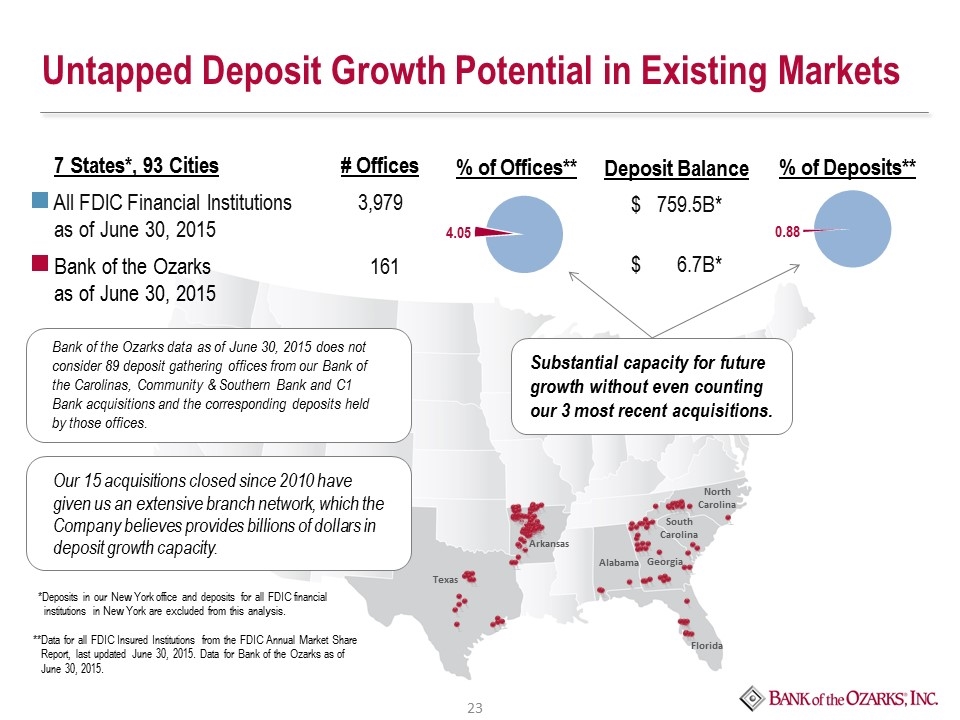
7 States*, 93 Cities # Offices All FDIC Financial Institutions as of June 30, 2015 3,979 Bank of the Ozarks as of June 30, 2015 161 % of Deposits** Untapped Deposit Growth Potential in Existing Markets *Deposits in our New York office and deposits for all FDIC financial institutions in New York are excluded from this analysis. **Data for all FDIC Insured Institutions from the FDIC Annual Market Share Report, last updated June 30, 2015. Data for Bank of the Ozarks as of June 30, 2015. Florida Texas North Carolina Georgia Alabama South Carolina Arkansas % of Offices** Deposit Balance $ 759.5B* $ 6.7B* Substantial capacity for future growth without even counting our 3 most recent acquisitions. Our 15 acquisitions closed since 2010 have given us an extensive branch network, which the Company believes provides billions of dollars in deposit growth capacity. Bank of the Ozarks data as of June 30, 2015 does not consider 89 deposit gathering offices from our Bank of the Carolinas, Community & Southern Bank and C1 Bank acquisitions and the corresponding deposits held by those offices.
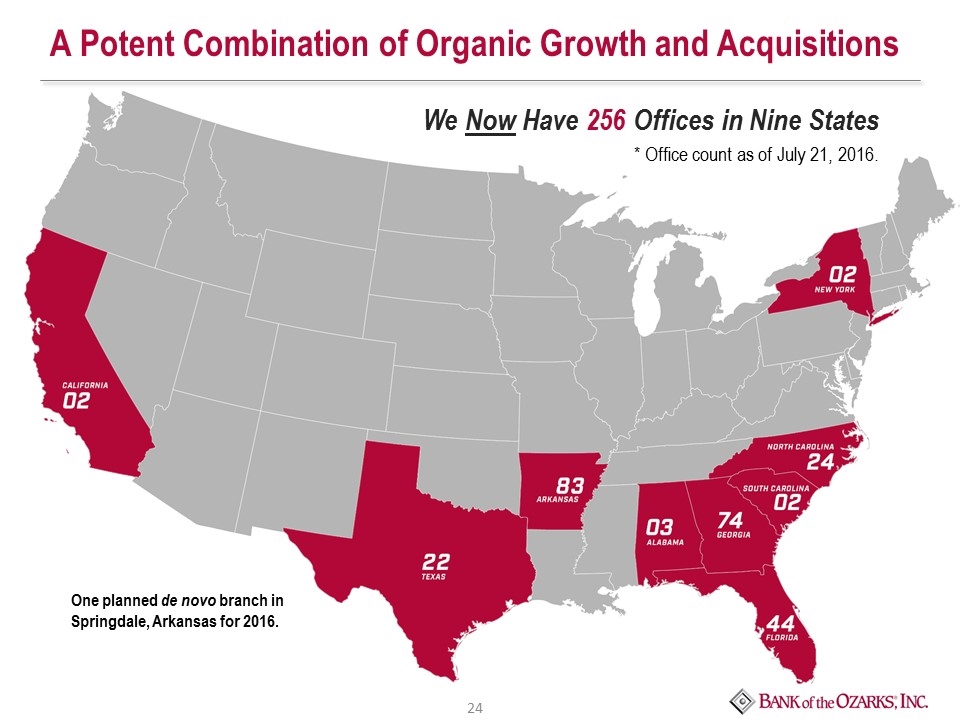
We Now Have 256 Offices in Nine States A Potent Combination of Organic Growth and Acquisitions * Office count as of July 21, 2016. One planned de novo branch in Springdale, Arkansas for 2016.
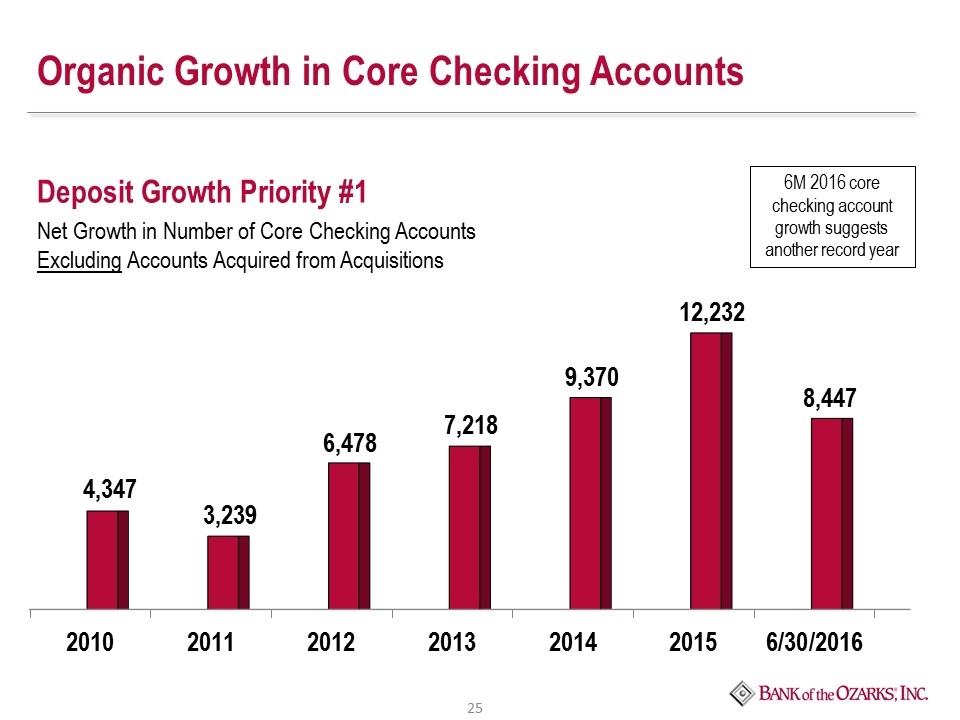
Organic Growth in Core Checking Accounts Net Growth in Number of Core Checking Accounts Excluding Accounts Acquired from Acquisitions 6M 2016 core checking account growth suggests another record year Deposit Growth Priority #1
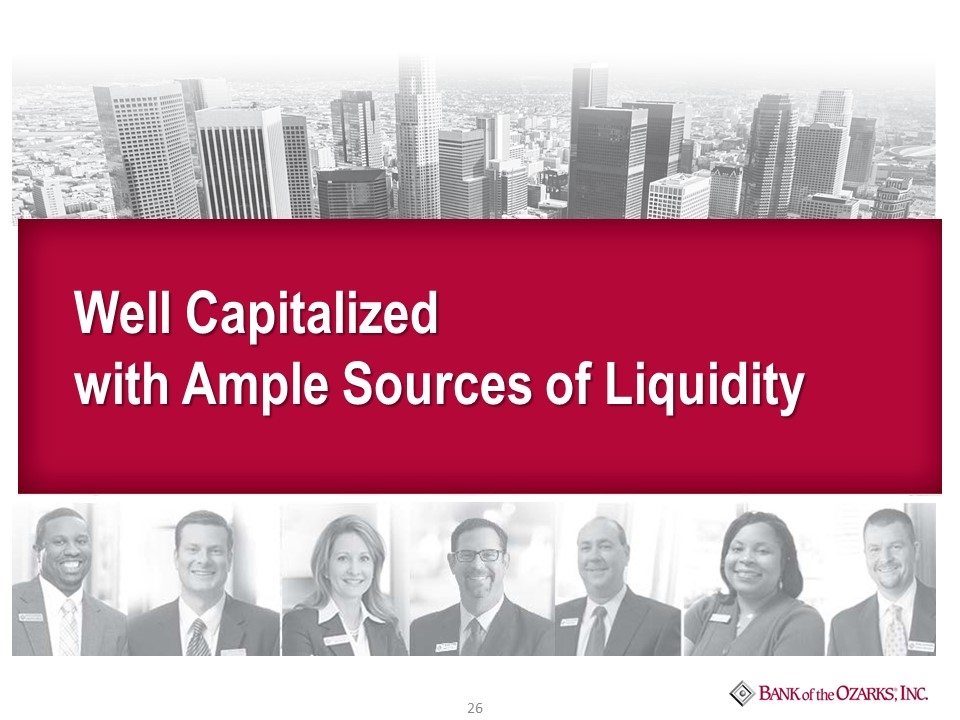
Well Capitalized with Ample Sources of Liquidity
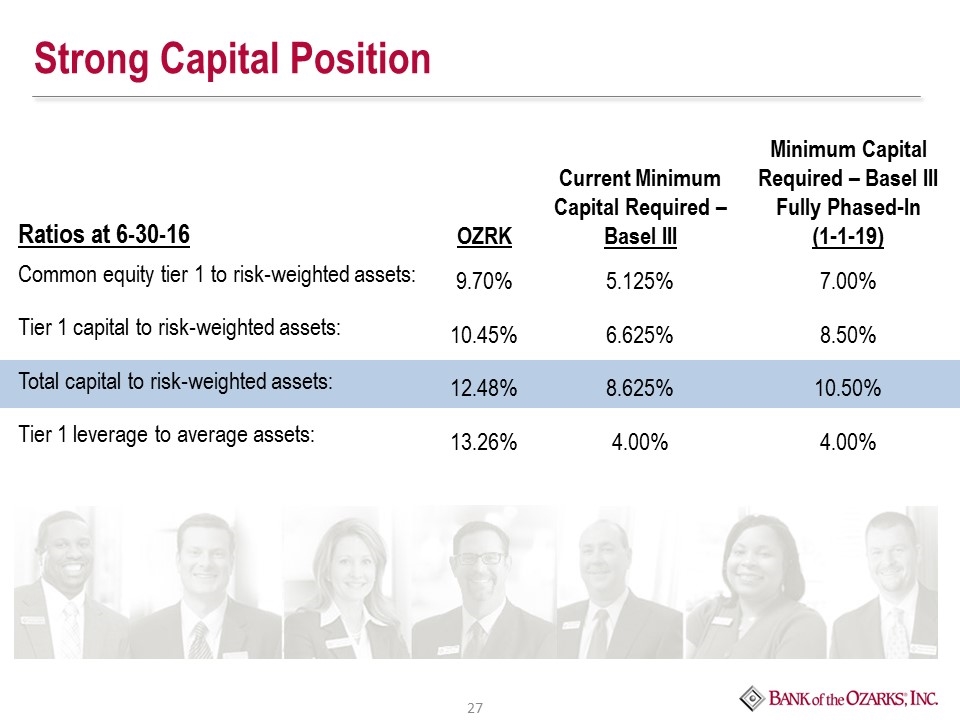
Ratios at 6-30-16 OZRK Current Minimum Capital Required – Basel III Minimum Capital Required – Basel III Fully Phased-In (1-1-19) Common equity tier 1 to risk-weighted assets: 9.70% 5.125% 7.00% Tier 1 capital to risk-weighted assets: 10.45% 6.625% 8.50% Total capital to risk-weighted assets: 12.48% 8.625% 10.50% Tier 1 leverage to average assets: 13.26% 4.00% 4.00% Strong Capital Position
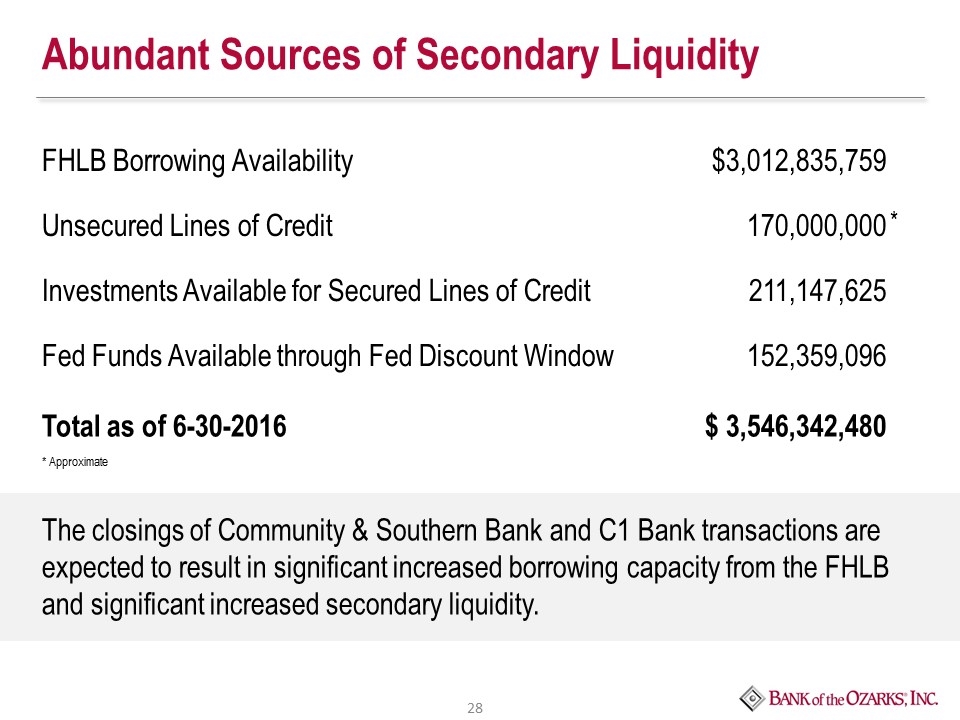
Abundant Sources of Secondary Liquidity FHLB Borrowing Availability $3,012,835,759 Unsecured Lines of Credit 170,000,000 Investments Available for Secured Lines of Credit 211,147,625 Fed Funds Available through Fed Discount Window 152,359,096 Total as of 6-30-2016 $ 3,546,342,480 * Approximate * The closings of Community & Southern Bank and C1 Bank transactions are expected to result in significant increased borrowing capacity from the FHLB and significant increased secondary liquidity.
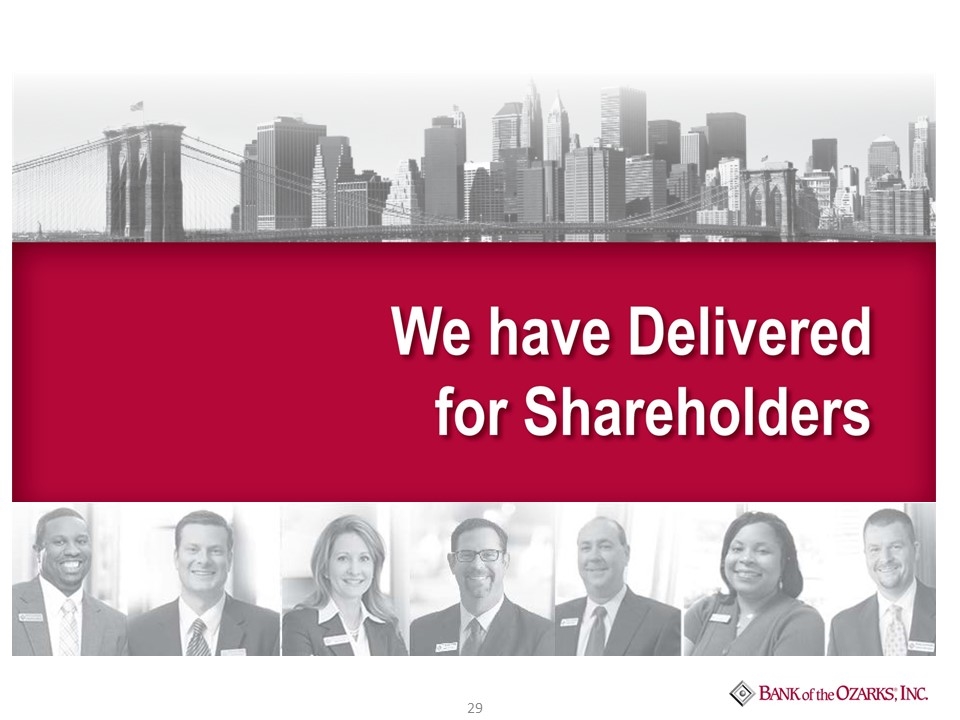
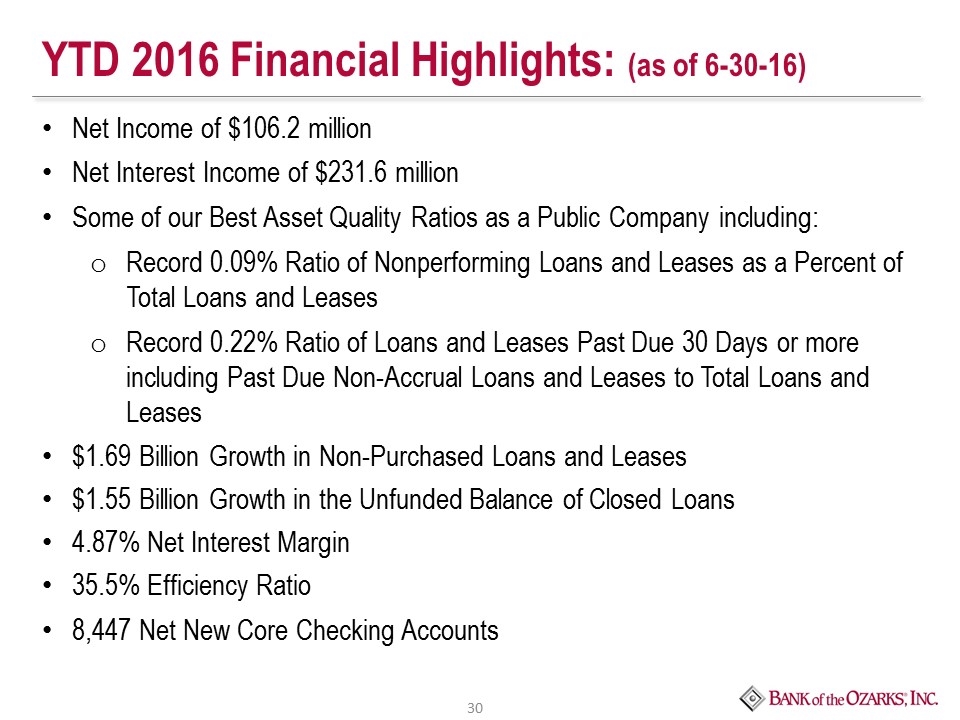
YTD 2016 Financial Highlights: (as of 6-30-16) Net Income of $106.2 million Net Interest Income of $231.6 million Some of our Best Asset Quality Ratios as a Public Company including: Record 0.09% Ratio of Nonperforming Loans and Leases as a Percent of Total Loans and Leases Record 0.22% Ratio of Loans and Leases Past Due 30 Days or more including Past Due Non-Accrual Loans and Leases to Total Loans and Leases $1.69 Billion Growth in Non-Purchased Loans and Leases $1.55 Billion Growth in the Unfunded Balance of Closed Loans 4.87% Net Interest Margin 35.5% Efficiency Ratio 8,447 Net New Core Checking Accounts
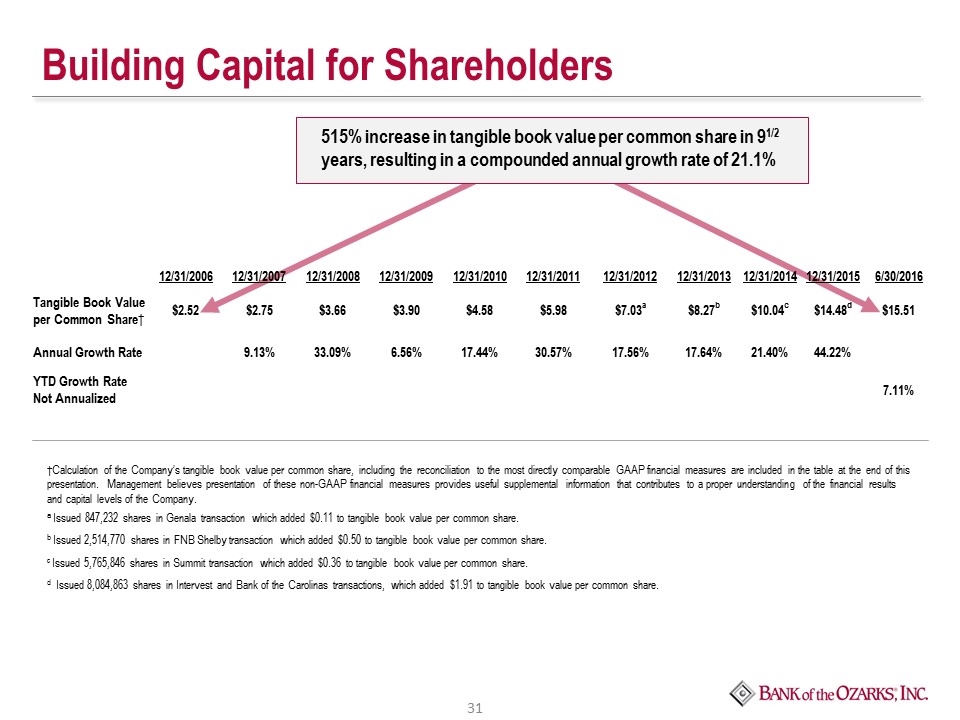
Building Capital for Shareholders †Calculation of the Company’s tangible book value per common share, including the reconciliation to the most directly comparable GAAP financial measures are included in the table at the end of this presentation. Management believes presentation of these non-GAAP financial measures provides useful supplemental information that contributes to a proper understanding of the financial results and capital levels of the Company. a Issued 847,232 shares in Genala transaction which added $0.11 to tangible book value per common share. b Issued 2,514,770 shares in FNB Shelby transaction which added $0.50 to tangible book value per common share. c Issued 5,765,846 shares in Summit transaction which added $0.36 to tangible book value per common share. d Issued 8,084,863 shares in Intervest and Bank of the Carolinas transactions, which added $1.91 to tangible book value per common share. 12/31/2006 12/31/2007 12/31/2008 12/31/2009 12/31/2010 12/31/2011 12/31/2012 12/31/2013 12/31/2014 12/31/2015 6/30/2016 Tangible Book Value per Common Share† $2.52 $2.75 $3.66 $3.90 $4.58 $5.98 $7.03a $8.27b $10.04c $14.48d $15.51 Annual Growth Rate 9.13% 33.09% 6.56% 17.44% 30.57% 17.56% 17.64% 21.40% 44.22% YTD Growth Rate Not Annualized 7.11% 515% increase in tangible book value per common share in 91/2 years, resulting in a compounded annual growth rate of 21.1%
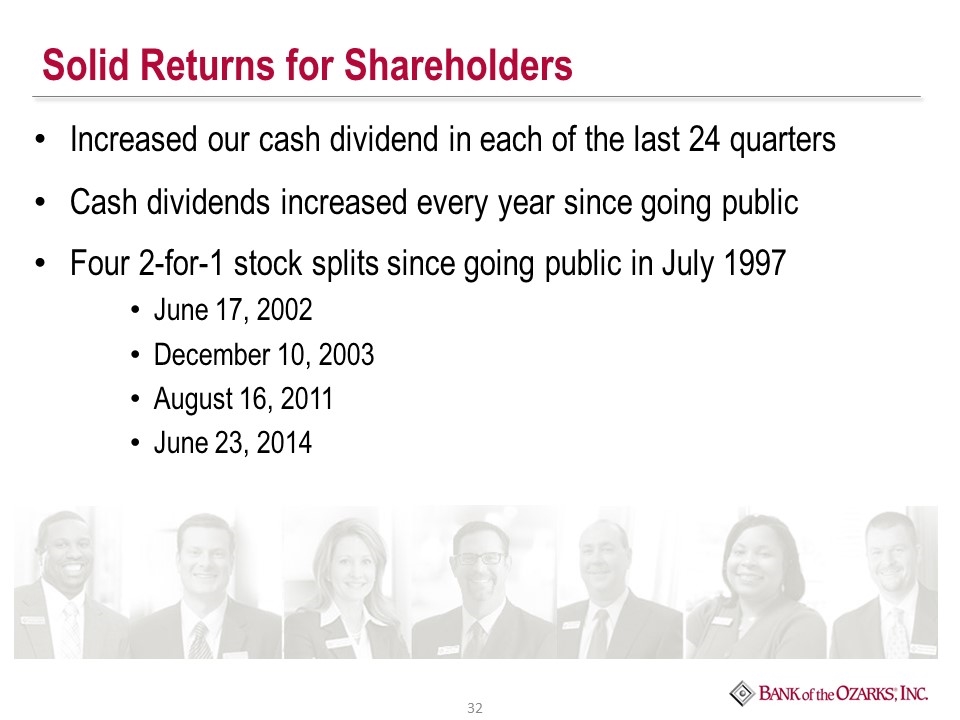
Solid Returns for Shareholders Increased our cash dividend in each of the last 24 quarters Cash dividends increased every year since going public Four 2-for-1 stock splits since going public in July 1997 June 17, 2002 December 10, 2003 August 16, 2011 June 23, 2014
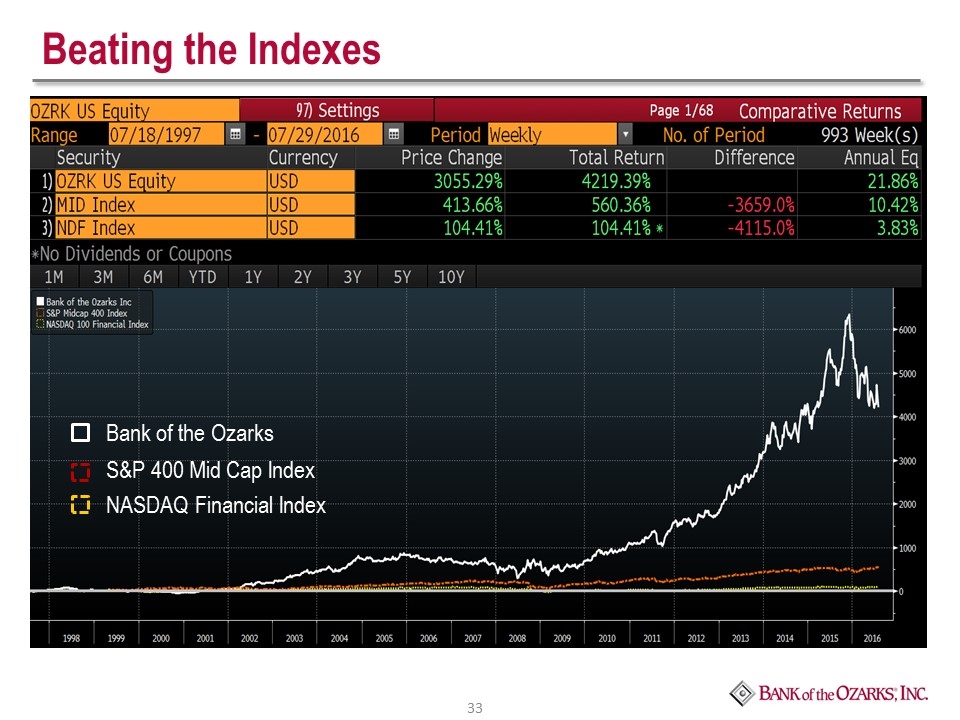
Bank of the Ozarks S&P 400 Mid Cap Index NASDAQ Financial Index Beating the Indexes
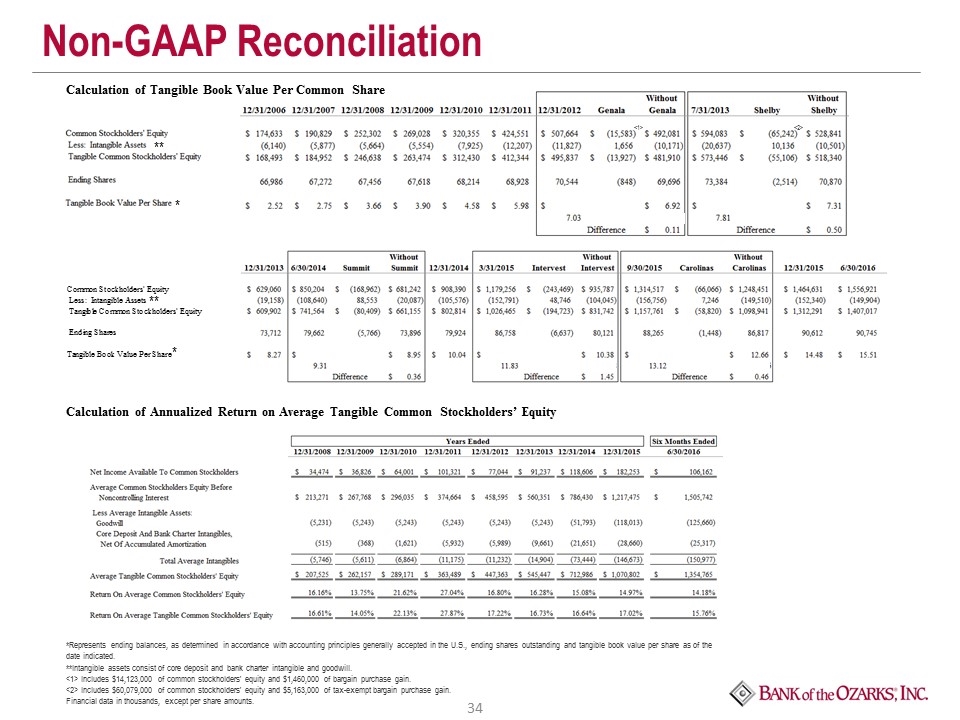
<1> <2> ** ** * * *Represents ending balances, as determined in accordance with accounting principles generally accepted in the U.S., ending shares outstanding and tangible book value per share as of the date indicated. **Intangible assets consist of core deposit and bank charter intangible and goodwill. <1> Includes $14,123,000 of common stockholders' equity and $1,460,000 of bargain purchase gain. <2> Includes $60,079,000 of common stockholders' equity and $5,163,000 of tax-exempt bargain purchase gain. Financial data in thousands, except per share amounts. Non-GAAP Reconciliation Calculation of Tangible Book Value Per Common Share Calculation of Annualized Return on Average Tangible Common Stockholders’ Equity



































